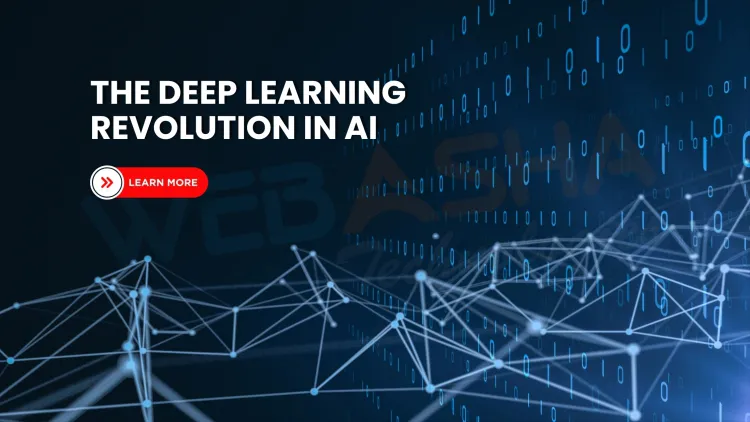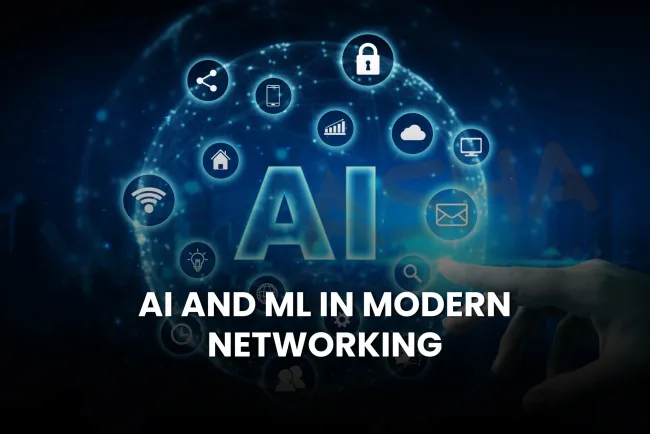What is the history of AI and how did deep learning transform it? The Detailed Guide
Artificial Intelligence (AI) began in the 1950s with rule-based systems and has evolved dramatically over time. The introduction of deep learning in the mid-2000s revolutionized the field by enabling machines to learn complex patterns through neural networks. Major breakthroughs like ImageNet (2012), the rise of transformer models (e.g., BERT, GPT), and large foundation models from 2020 onwards have shaped modern AI. Deep learning enabled rapid advances in vision, language, and decision-making, bringing AI to real-world applications like chatbots, healthcare, cybersecurity, and more.

Table of Contents
- What Is Artificial Intelligence and Deep Learning?
- The Early Days of AI (1950s–1980s)
- Rise of Machine Learning (1990s–2000s)
- Birth of Deep Learning (2006–2012)
- Explosion of Deep Learning (2013–2020)
- The GPT Era and Foundation Models (2020–2024)
- How Deep Learning Works (Simplified)
- Applications of Deep Learning Today
- Challenges and Concerns
- Conclusion
- Frequently Asked Questions (FAQs)
Artificial Intelligence (AI) has transformed our world—from early rule-based machines to today's powerful language models like ChatGPT and GPT-4. One of the most important developments that made modern AI possible is deep learning, a subset of machine learning that mimics the human brain.
In this blog, we’ll take a look at the evolution of AI, how deep learning shaped its progress, and where the future might take us.
What Is Artificial Intelligence and Deep Learning?
Artificial Intelligence refers to machines that can simulate human-like intelligence—like decision-making, problem-solving, or understanding language.
Deep Learning is a specific technique within AI that uses neural networks with many layers to automatically learn patterns from data.
These deep networks allow systems to learn complex representations, enabling breakthroughs in voice assistants, self-driving cars, and more.
The Early Days of AI (1950s–1980s)
-
1950: Alan Turing proposes the idea of a "thinking machine" in his famous paper, introducing the Turing Test.
-
1956: The term “Artificial Intelligence” is coined at the Dartmouth Conference, marking the official birth of AI.
-
Early programs like ELIZA (1966) simulated human conversation using simple pattern matching.
-
AI struggled during this period due to limited computing power and data, leading to the first “AI Winter”—a time when interest and funding dried up.
Rise of Machine Learning (1990s–2000s)
In the 1990s, researchers shifted from rule-based systems to machine learning, where algorithms learn from data.
-
Support Vector Machines (SVM) and Decision Trees became popular.
-
IBM’s Deep Blue defeated chess champion Garry Kasparov in 1997.
-
Still, these systems lacked the ability to handle complex features like vision or speech.
Birth of Deep Learning (2006–2012)
The deep learning era truly began in the mid-2000s when researchers like Geoffrey Hinton, Yann LeCun, and Yoshua Bengio revived neural networks.
-
2006: Hinton introduced the idea of "deep belief networks", showing how to train multi-layer networks effectively.
-
2012: The ImageNet competition was won by AlexNet, a deep convolutional neural network (CNN), reducing image classification error rates drastically.
This marked the turning point where deep learning started outperforming traditional methods.
Explosion of Deep Learning (2013–2020)
With increasing data, better algorithms, and GPUs, deep learning started changing the world:
-
2014: GANs (Generative Adversarial Networks) introduced by Ian Goodfellow.
-
2015–2018: Google’s TensorFlow and Facebook’s PyTorch made deep learning development accessible.
-
NLP breakthroughs:
-
2018: Google’s BERT and OpenAI’s GPT series transformed language understanding.
-
Chatbots, translators, and recommendation systems improved dramatically.
-
The GPT Era and Foundation Models (2020–2024)
The modern AI landscape is dominated by large-scale models trained on massive datasets.
| Year | Model | Milestone |
|---|---|---|
| 2020 | GPT-3 | 175B parameters; multi-task NLP |
| 2021 | DALL·E, CLIP | Image + text understanding |
| 2022 | ChatGPT | Popularized generative AI |
| 2023 | GPT-4 | Multimodal AI; better reasoning |
| 2024 | Claude, Gemini | Open competition from Anthropic, Google |
These models are now powering enterprise AI, education, healthcare, and even autonomous agents that think and act.
How Deep Learning Works (Simplified)
Deep learning uses neural networks structured like layers of virtual neurons. Each layer transforms the data slightly and passes it to the next.
A basic neural network looks like:
Input Layer → Hidden Layers → Output Layer
The more hidden layers, the “deeper” the network. These layers automatically learn features—like edges in images or grammar in text.
Popular architectures:
-
CNNs for images
-
RNNs & Transformers for sequences and language
-
GANs for generating data (e.g., fake images)
Applications of Deep Learning Today
-
Healthcare: Diagnosing cancer from images, drug discovery
-
Finance: Fraud detection, algorithmic trading
-
Education: AI tutors, language models for learning
-
Entertainment: AI-generated music, deepfake videos
-
Cybersecurity: Intrusion detection using anomaly detection
Challenges and Concerns
While powerful, deep learning isn’t perfect.
-
Bias in data → biased predictions
-
High energy use → environmental impact
-
Black-box nature → difficult to explain decisions
-
Job disruption → automation of human roles
Efforts like Explainable AI (XAI) and AI Ethics are now major areas of research.
What’s Next for AI and Deep Learning?
The future is headed toward:
-
Smaller, faster models for mobile and edge devices
-
Self-improving agents that can plan and act (e.g., ChatGPT Agents)
-
General AI (AGI): Systems that reason and learn like humans
-
AI governance to ensure safety, fairness, and accountability
As deep learning matures, we’ll likely see more hybrid models, combining symbolic reasoning with neural nets—bringing us closer to true intelligence.
Conclusion
Deep learning changed AI from a research curiosity to a revolutionary force. From the early neural nets of the 1980s to today’s giant multimodal models, we’ve come a long way.
But we’re still only scratching the surface of what’s possible.
Whether you're a student, developer, or curious mind, understanding the history of AI with deep learning helps you see where we’ve been—and where we’re headed.
FAQ
What is deep learning in simple words?
Deep learning is a type of AI that teaches computers to learn from data using layered neural networks, just like the human brain.
When did artificial intelligence begin?
AI began in the 1950s with early concepts proposed by Alan Turing and formalized at the Dartmouth Conference in 1956.
Who is the father of deep learning?
Geoffrey Hinton is often called the "Godfather of Deep Learning" due to his pioneering work in neural networks.
What was the turning point for deep learning?
The 2012 ImageNet competition, won by AlexNet, was the key turning point that showed the power of deep learning.
What are the main applications of deep learning today?
Deep learning is used in image recognition, speech translation, self-driving cars, chatbots, healthcare diagnosis, and fraud detection.
What is the difference between machine learning and deep learning?
Machine learning uses algorithms to find patterns in data, while deep learning uses multi-layered neural networks for more complex tasks.
How does a neural network work?
A neural network processes data in layers, with each layer transforming inputs into higher-level features to make predictions.
What is a convolutional neural network (CNN)?
CNNs are deep learning models designed for image and video processing.
What role did GPUs play in deep learning?
GPUs allowed faster processing of neural network computations, enabling large-scale deep learning research.
What is a transformer in AI?
A transformer is a deep learning model architecture used in natural language processing tasks, powering models like BERT and GPT.
What are foundation models?
Foundation models are large-scale AI models trained on broad data to perform many tasks, such as GPT-4 or Gemini.
How big is GPT-3?
GPT-3 has 175 billion parameters, making it one of the largest models when it launched in 2020.
What is AGI in AI?
AGI, or Artificial General Intelligence, refers to machines that can perform any task a human can.
What are some examples of deep learning tools?
Popular tools include TensorFlow, PyTorch, Keras, OpenCV, and Hugging Face Transformers.
What is the future of deep learning?
The future includes smaller, efficient models, explainable AI, and possibly the emergence of general intelligence.
How did deep learning impact NLP?
Deep learning enabled machines to understand and generate human language through models like GPT and BERT.
What is BERT used for?
BERT is used for understanding natural language, especially in tasks like search engines and chatbots.
What was the AI Winter?
AI Winter refers to periods when interest and funding for AI dropped due to failed expectations in the 1970s and 1980s.
What is a GAN in AI?
GAN stands for Generative Adversarial Network, a model that generates realistic images or data using two competing networks.
What makes deep learning so powerful?
Its ability to automatically learn features from raw data without manual programming makes it powerful.
What are some ethical concerns in AI?
Bias in training data, job loss, lack of transparency, and misuse of generative AI are major ethical concerns.
Why is AI training energy-intensive?
Large AI models require vast computational power, leading to high energy use and environmental concerns.
What is explainable AI (XAI)?
XAI refers to methods that make AI decisions more understandable to humans, improving trust and transparency.
Is deep learning used in cybersecurity?
Yes, deep learning is used for malware detection, anomaly detection, phishing identification, and more.
Can deep learning replace human intelligence?
Not yet. While it can perform complex tasks, it still lacks reasoning, emotional understanding, and real-world judgment.
What is reinforcement learning?
It’s a type of machine learning where agents learn by interacting with the environment to maximize rewards.
Why is AI trending now?
Improved hardware, massive datasets, and advanced models have made AI accessible and useful in real-world applications.
What programming languages are used in deep learning?
Python is the most widely used language due to its libraries like TensorFlow and PyTorch.
What is the Turing Test?
It’s a test to determine if a machine can exhibit intelligent behavior indistinguishable from a human.
How is AI used in healthcare?
AI helps with diagnostics, predictive analysis, personalized medicine, and robotic surgery.











![Top 10 Ethical Hackers in the World [2025]](https://www.webasha.com/blog/uploads/images/202408/image_100x75_66c2f983c207b.webp)



![[2025] Top 100+ VAPT Interview Questions and Answers](https://www.webasha.com/blog/uploads/images/image_100x75_6512b1e4b64f7.jpg)







